If you love flowers, if you love needlework, if you love historical and modern embroidery techniques, if you love museums and collections and threads and unique things, if you love costuming and accessories…well. Here’s a book for you!
Embroidered Treasures: Flowers is a book that brings to life, for you and me, the embroidered flowers found on items of needlework in the collection held by the Embroiderers’ Guild of the UK. It’s a fascinating book – one that you’ll want to pore over, contemplate, and absorb.
When I first heard this book was coming out, I immediately put it on my List and then eagerly anticipated it for months. It does not disappoint!
Let’s look at it up close! I’ll show you just a mere portion of the inspiration offered in this incredibly beautiful book – enough to illustrate what it’s all about – and tell you where you can find it today. It’s not available everywhere just yet, and I kind of suspect it’s going to be a popular book (like museum collection catalogs – they never seem to hang around long enough!).
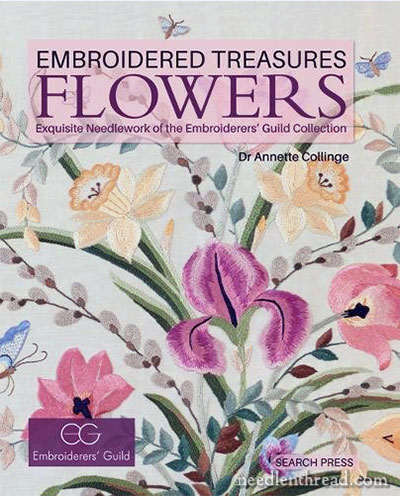
Embroidered Treasures: Flowers is a hard cover book with a colorful cover (and dust jacket) that hints at the delights within.
The book is not a how-to book or a project book. It’s a catalog of items in the Embroiderers Guild collection, with detailed information about each item – the provenance, techniques, materials used, close-ups of the stitching, and so forth.
And while it might not be exactly an instructional book, you’ll definitely learn a lot from it!
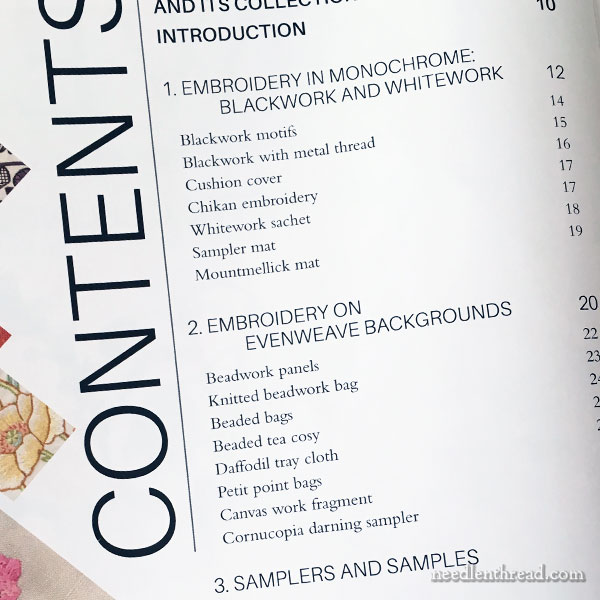
To give you an idea of the format of the book, here’s a glance at a small fraction of the contents.
The book is divided into different qualifications, as follows:
Embroidery in monochrome (blackwork & whitework)
Embroidery on even-weave (counted, beadwork, canvas work)
Samplers and samples (works stitches as samplers or as a collection of samples of a type of needlework or a type of design)
Needle lace (including 17th century techniques)
Applied materials (including slips, silk ribbon work, felted appliqué and more)
Embroidery with unusual materials (think: fish scales, straw…)
Metal thread embroidery
Stitches and more stitches (embroidery worked with a variety of stitches)
Silk and wool
Machine embroidery
Symmetry in stitches (symmetrical designs)
Irregular designs
There are fantastic examples of embroidery in ever chapter!
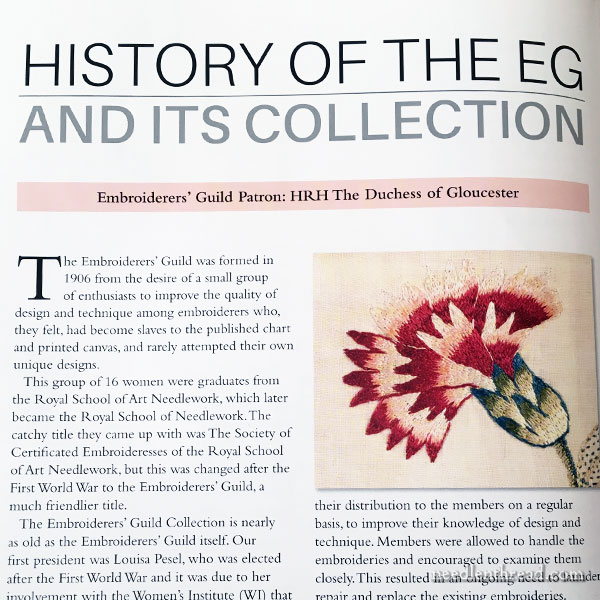
The book begins with a short history of the Embroiderers’ Guild and its collection by Dr. Annette Collinge. Fascinating reading! I think it’s interesting to see that there’s a clear difference between the Embroiderers’ Guild in the UK and its development, compared to the EGA (Embroiderers’ Guild of America).
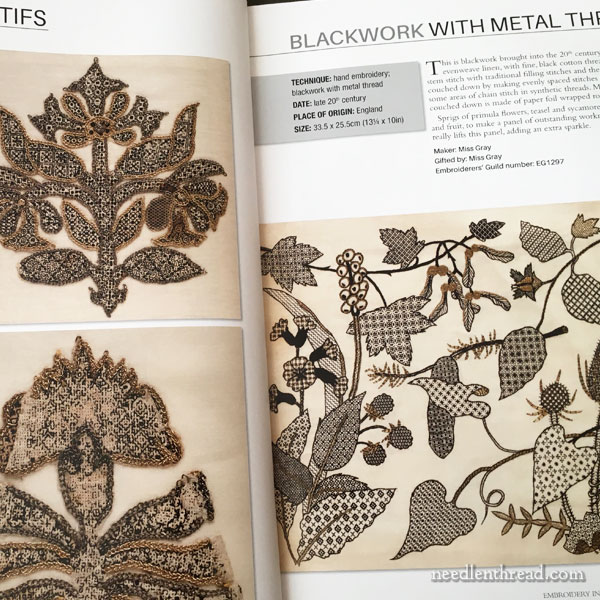
After a short introduction, we move straight into the collection!
Each spread presents anywhere from one to several pieces of embroidery, along with details of provenance, materials, techniques, and a thorough and really readable description of the piece.
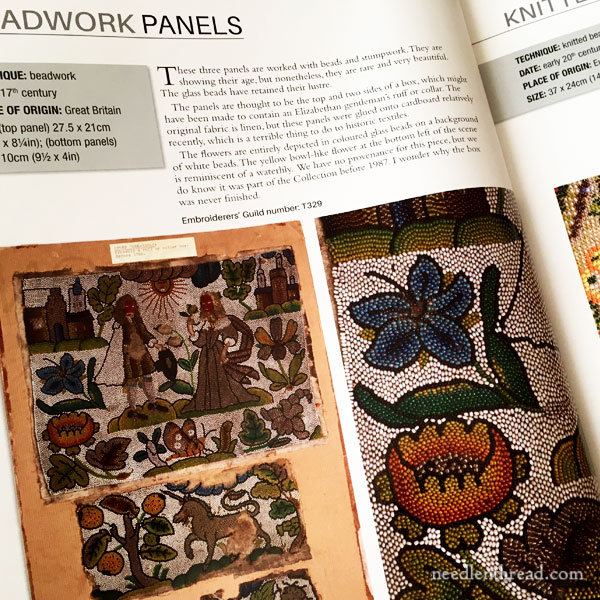
You even get a sense of the “personalities” of the pieces in these descriptions. For example, I chucked at the description of a silk and goldwork flower panel: “This is a flower with an attitude. It’s meant to be seen from a distance.”
In this way, Collinge makes the collection very accessible as she guides the viewer through the pieces.
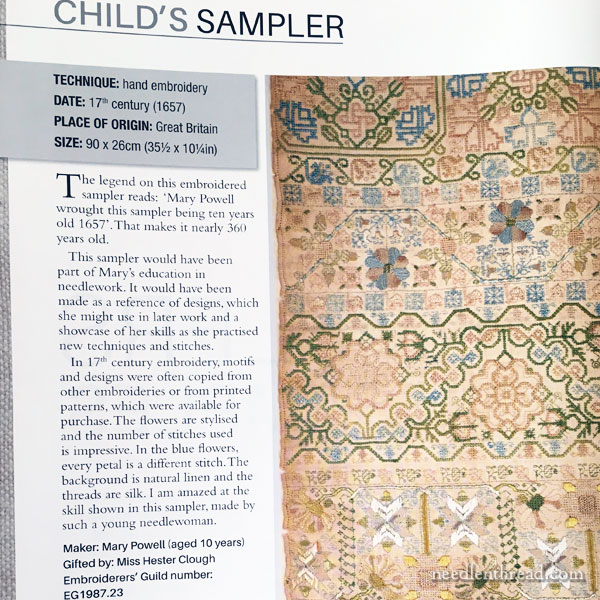
Think of the pleasure you get from visiting a museum or place of historical interest in company with someone who really knows their stuff and who can make the story behind the place or the pieces come to life, by putting them into context with history and with other similar things – and that’s what you get in this book.
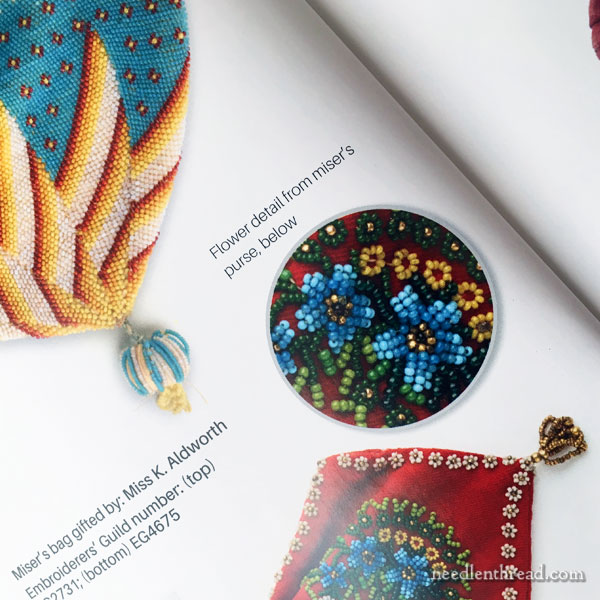
For the stitcher and for the aspiring designer, there’s a lot here, too!
You’ll often find close-ups on elements that you can learn from, just by virtue of seeing them close up!
In most museums and most collections, you’d never get the opportunity to get this close the pieces and to look at them for this long and to study them in any depth.
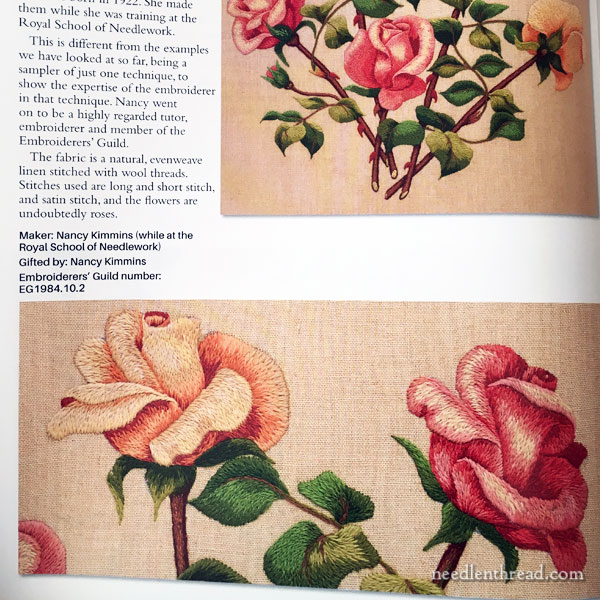
I especially love being able to see clear stitch details on many of the pieces.
There are numerous vibrant examples of embroidery in the book, from antique to modern – many examples for every preference.
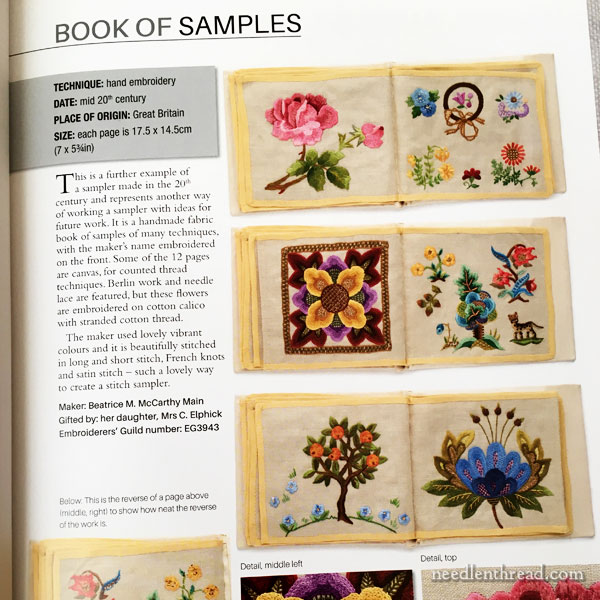
The book of samples shown above ranks high among one of my favorite pieces…
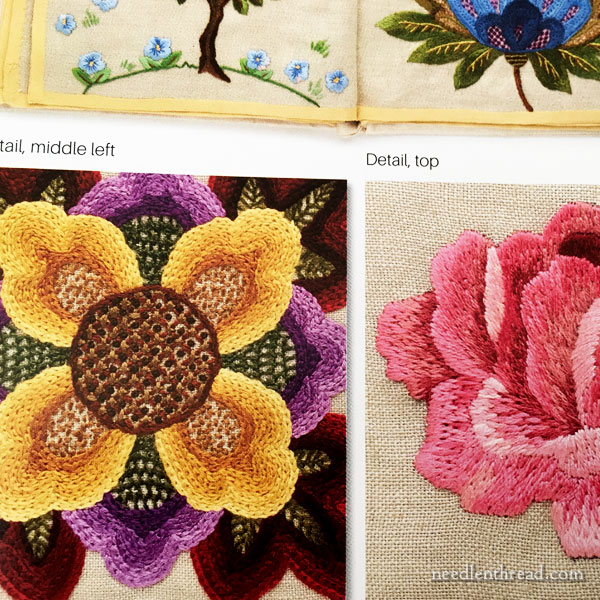
…and I especially love the detail photos!
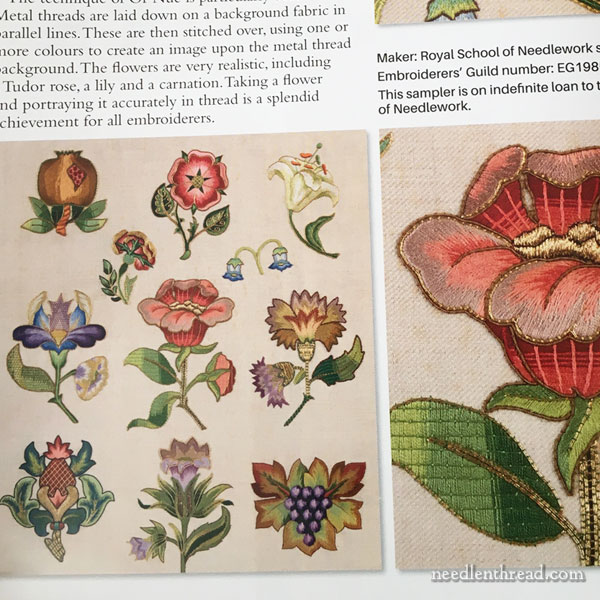
And this is another favorite that you’ll want to find out more about.
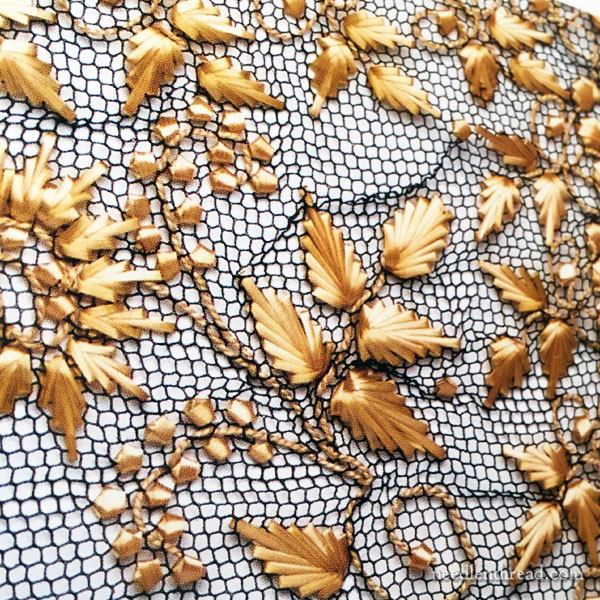
Amazing how something as seemingly simple as straw can produce such a luxurious look, isn’t it? Definitely worth reading about!
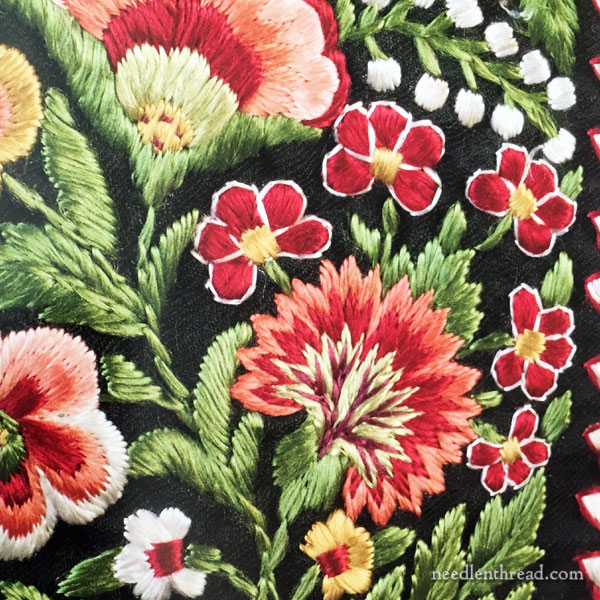
And as far as eye-catchers go, is this not gorgeous?
Aaaaaaaaah. I love this piece! I love the detail in the thread – look at that sumptuous, soft, gleaming silk!
In a Nutshell
Embroidered Treasures: Flowers is a fantastic book! It’s inspirational. It’s informative. It’s beautiful!
For most of us who will never see a collection of embroideries like these up close and personal, this lovely book is the best way to experience them and learn about them. We can take what we learn and apply it to our own needlework pursuits. Or we can just enjoy the beauty of the pieces and appreciate the history behind them.
It’s a great book for your reference library… and even for your coffee table!
Where to Find It
You can find Embroidered Treasures: Flowers available through the following book affiliates:
Worldwide, with free shipping, Embroidered Treasures: Flowers is available here from Book Depository. It’s available now!
In the US, the Embroidered Treasures: Flowers is available here through Amazon, but it won’t be released here until the beginning of March. You can pre-order it now.







I love this book. It’s beautiful. I, too, eagerly awaited its publication for months (it seemed like years!).
I guess I’m greedy, however. I wish there were even more detail photos. There’s one set of items, in particular, where only one of the items has a closeup photo. I wish I could see all the items in detail.
I can’t wait for the next book in the series on birds!
I know, I know, I know! I always want MORE, too! And I can’t wait for the birds, either. I love having books to look forward to – as long as they don’t disappoint! 🙂
You’d think I’d know from experience that I don’t really have to read your book review to know that I’m going to be putting it on my wish list. You are SUCH an enabler Mary!!
LOL! But it IS a nice book, MaryAnn! 🙂 I like just picking it up and flipping through it for a browse – for the twentieth browse, even!
Dear Mary
From you description The collection for the book Embroidered Treasurers: Flowers is a beautiful book full of wonderful photos and an array of flowers. There is a lot of information on different aspects of embroidery from the content page you’ve shown and I can imagine the rest of the book is full of wonderful embroidered pieces. Thanks for your review on the book and for sharing the lovely photos on Embroidered Treasures: Flowers with us it looks a lovely book full of wonderful embroidered pieces.
Regards Anita Simmance
Hi Mary –
I wandered into your list of reviewed books this morning and wanted to see the review of “White Work” by Carter Houck. The link took me to a general article on whitework with no mention of the book. Is there more somewhere?
Thanks from Ann.
Hi, Ann – Oh, my – that’s one of the oldest articles on the website, and I really need to update it! It used to have photos of the book you’re talking about, but in the various upgrades on the site, those have been lost along the way. The book is very simple. There are decent brief diagrams for typical stitches used in whitework at the beginning (in black and white). The rest of the book features patterns typical of whitework embroidery. It’s published by Dover, it’s an inexpensive paper back with some nice designs in it (they can also be used for regular colored embroidery, too), and it’s available here through Amazon (where you can look inside – use the “Surprise Me” feature a few times, and you’ll be able to see what kinds of patterns the book features) and through other book outlets. Hope that helps!
Thanks for the recommendation! I really love books that give the history of embroidery-such a rich and fascinating history. Of course, I immediately had to order it.
Thank you for your terrific blog! Just love it!
You and me both, Becky! This book fulfilled all my “loves” in a book – a bit of history, a bit of needlework, and a bit of a story now and then!
What technique and materials are used for the flowers all stitched in something goldish? Are they somekind of gold threads or beads ?
Hi, Rose – do you mean the piece on the black net background? That’s actually straw, of all things! Beautiful, isn’t it?
Wow, that so blowed my mind. Starw???? Never would have crossed my mind. Very beautiful and somebody really had a lot of patience and skills to make that project look so awesome.Thank you for the answers.
You have written a beautiful review! I clearly must have this book if for no other reason than to study the roses. They are just gorgeous.
Thank you for sharing this, Mary! What a gorgeous book. Off to pre-order right now!
Happy New Year to you and all Mary.
Like you Mary I love to be able to get up close to the needle work to see the stitches. You give good close up shots at times and it seems to me all the more enjoyable, when you can hold the photo further away and see how the picture clears and looks smooth and the over all effect.
Thanks for another informative newsletter. Hope your plans all go smoothly and are fruitful.
Cheers
MM
Hi Mary,
What a beautiful book I have just been over to the book depository and ordered it and I was extremely surprised at the cost of it in Aust dollars, I would have expected it to be at least $20 to $30 more. I can hardly wait for it to arrive.
Many thanks for the review.
Cheers Judy
Hi Mary,
First I want to say I am so glad your health is better.
I ordered some fine tip iron pens from sublime. I can not get them to work. Any suggestions?
Thank you
Rose
Hi, Rose – wow, that’s odd. Are they marking the paper you’re tracing on – that is, are you getting ink out of them as you draw with them? Once you’ve drawn your design with them onto the paper (reversing it, if necessary) you heat up your fabric (which should already be ironed and wrinkle-free), place the pattern ink-side down (I’d pin three corners), and hold the iron on it for a slow count of about 6. Then lift one corner and check. Don’t iron back and forth – just lift the iron and replace in a new spot. That’s the normal procedure for ironing on a pattern. If the pen isn’t giving you any ink or anything, then I’d definitely contact Jenny Hart at Sublime Stitching, to see if there is a defect. I’ve had great luck with them, so I hope it’s not a matter of a defective pen.
Thank you so much for posting this. It is such wonderful useful information for this new stitcher!!
I am currently cross-stitching a baby blanket for my nephew. I have a pattern that I would like to do on a 14-count fabric. I have Zweigart’s 14-count Novara afghan for the back (which feels great as a baby blanket). Is there a 14-count non-synthetic, non-patterned (or large central blank area) fabric that has the same feel as afghan that you would suggest? I have tried a 28-count Lugana fabric but it feels too stiff. I have also found several afghans but they either are polyacrylic, have a pattern (borders dividing fabric into squares) or are not-14-count.
Hi, Laura – You might look for 14 count “Salem cloth.” It’s 100% cotton, and apparently washes up very soft.
Mary,
Thank you so much for such a timely response! I looked into Salem Cloth as you suggested and according to this list, it is not made from cotton : http://www.needlestack.com/documents/Fabric-List.pdf (or I am mistaken somehow). Would you have any other suggestions on a fabric I might use? Any information you provide would be greatly appreciated!
-Laura
Hi, Laura – perhaps they make it with different fibers? This one on Nordic Needle is listed as 100% cotton: https://www.nordicneedle.com/8915
I haven’t ever used it, so I don’t know for sure!
How did I not know about this book!
If you like embroidered flowers and Embroidery History, you want to get ‘Twixt Art and Nature. It’s an Out Of Print Met.useum book which is available as a free PDF.
Susan